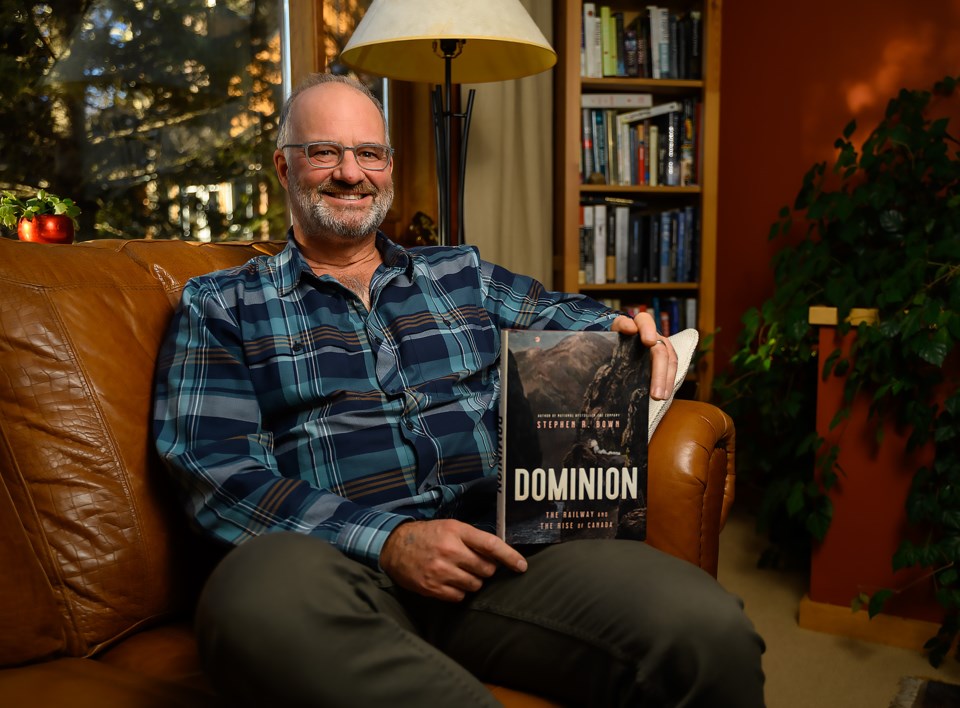CANMORE – Canmore’s Stephen R. Bown is on track to telling how Canada’s remarkable history really went down – nasty warts and all.
Many things make the Great White North a great place to live, but the darker elements of the nation’s past have become more widely known over the last few decades through survivors telling their stories and through the investigative work of writers and historians like Bown.
In his latest book, Dominion: The Railway and The Rise of Canada, Bown examines one of Canada’s defining moments as a nation, the massive engineering triumph of its time, its main players and pawns, greed, corruption and the terrible price it cost for many involved.
A meet and greet and book signing with the local author is set at Café Books in Canmore on Saturday (Dec. 2) from noon to 4 p.m.
Speaking toward his 10th book, Bown said the railway, which stemmed from “extreme anti-United States paranoia” is the spine of the story, but the colourful tales of those connected to it are what will catch the reader’s attention.
“The words dynamic and turbulent come to mind,” said Bown.
“You have lots of social change in that time period. That’s why it’s kind of an interesting time period to look at. As a historian … I just wanna present as many possible interpretations of that story, and there’s many points of view of people who lived then.”
More than 135 years old, the Canadian Pacific Railway (CPR) was built between Montreal, Quebec and Vancouver, British Columbia, to connect the east and west.
The last spike was driven into the ground to complete the iron road in November 1885, the same year Banff became a national park.
Locally, the CPR created new opportunities for tourists and settlers to come to Banff and the Canadian Rockies and, to this day, Banff is Canada’s flagship national park. In Canmore, the town was built around the railway, with people coming to mine for coal – much like what happened 25 kilometres west in Bankhead, the now ghost town at the toe of Cascade Mountain.
When the CPR was under construction, more than 5,000 kilometres of railway were built through the mountains, Canadian Shield, prairies and forests, often in harsh conditions and done by exploiting and abusing its workers, who were mostly foreign.
Problems surrounding the gigantic engineering project, such as environmental disasters and worker abuse have often been pushed aside in favour of cheerleading for nationalistic purposes, said Bown.
“If you look back in time, the early foundation of this country has some pretty dark shadows,” said Bown. “I just felt that it was my job to retell that story and include all those darker aspects to it, just like I did with [my book on the] fur trade.”
Have you ever wondered what life as a railway worker was like? Well, between the duties of working in dangerous climates and trying not to get blown up by dynamite, they were drinking heaps of booze like first-year college students, on the job.
It’s not surprising the CPR bosses tried their damnedest to get rid of the liquor when thousands of kilometres of tracks were being laid down.
“They tried to restrict liquor in the camps as much as possible, but there were creative and unusual ways of people trying to smuggle it in,” said Bown.
“A woman, who was caught with a giant bladder around her waist that was filled with whiskey, had been passing off as being pregnant. So she was dressed up as if she was pregnant, but when they searched her they discovered she wasn’t pregnant and there was just a giant sack of whiskey strapped around her midsection.”
Bown added that once the CPR was built, it was a great source of pride from the workers for accomplishing the mighty feat.
Available now, Dominion: The Railway and The Rise of Canada can be found at Cafe Books and online.




